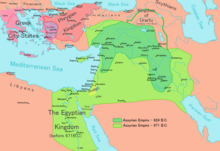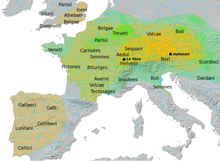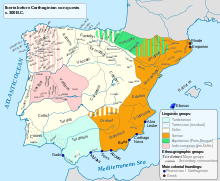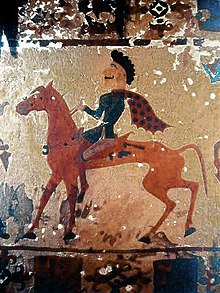Iron age
The Iron Age is a period of prehistory and early history named after the material used to make tools . After the Stone Age and the Bronze Age, it is the third major period in the simple temporal structure of the three-period system . The Iron Age extends in southern Central Europe from around 800 BC. Until the turn of the ages and in northern central Europe from about 750 BC. Until the 5th century AD
overview
In most regions, the first, isolated use of iron begins well before the respective Iron Age. It is only when iron is used more widely as a material that it is reflected in archaeological finds and is therefore suitable for periodization . According to the original concept, the Iron Age is a period of prehistory , but as its last section before the transition to historical times, written sources are already available in many cases, so that the Iron Age can then be assigned to early history . Especially in the English-language research, the notion of "Historical Iron Age" (comes Historic Iron Age ) apply if written sources are available.
Greatly simplified chronological comparison of the Iron Age in selected cultural regions:

middle East
Anatolia

Although in Anatolia as early as the 3rd millennium BC While iron was occasionally worked, the Iron Age begins as an archaeological period around 1200 BC. With the fall of the Hittite empire . The Anatolian Iron Age is usually divided into three phases:
- Early Iron Age: " Dark Ages "
- Middle Iron Age: Phrygian and Urartean times
- Late Iron Age: Persian Period
Additionally or alternatively, depending on the region, individual periods of time can be named after the respective ruling powers (especially Neo-Hittite , Assyrian , Lydian times ).
Mesopotamia
In Mesopotamia , the period from the Isin II period (1160-1026 BC) to the beginning of Hellenism is known as the Iron Age. It is shaped by several ancient oriental empires .
- Neo-Assyrian Period (1000–600 BC)
- Neo- Babylonian Period (1025–627 BC)
- Late Babylonian Period (626-539 BC)
- Achaemenid Period (539–330 BC)
Levant
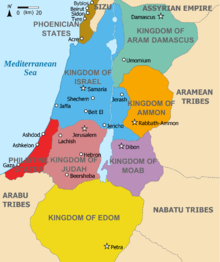
In the Levant , the upheavals around 1200 BC BC (see " Sea Peoples ") from the Bronze Age to the Iron Age:
- Iron Age I (1200–1000 BC)
- IA (1200–1150 BC)
- IB (1150–1000 BC)
- Iron Age II (1000-586 BC)
- II A (1000–925 BC)
- II B (925-700 BC)
- II C (700-586 BC)
- Iron Age III (586–332 BC)
- Babylonian Period (586-539 BC)
- Achaemenid Period (539–332 BC)
Since in the Babylonian and v. a. From the Persian period, written sources are available for the Levant and there are coins, these are no longer purely prehistoric periods. The Iron Age ends no later than 332 BC. With the conquest by Alexander the great and the beginning of Hellenism .
Cyprus
The Iron Age in Cyprus is similar to that in Greece, from where the Mycenaean culture had a great influence at the end of the Bronze Age .
- Cypriot-Geometric Period (1050–750 BC)
- Archaic Cypriot Period (750-475 BC)
In the course of the archaic period, Cyprus repeatedly came under the influence of its neighbors. Phoenician settlements have been established since the 9th century , later the island was part of the rulers of Assyria (707–612 BC), Egypt (570–526 / 525 BC) and Persia (from 526/525 BC). Chr.).
Europe
Greece
In Greece , after the end of the Late Bronze Age Mycenaean culture (approx. 1600-1050 BC) and a sub-Mycenaean phase (approx. 1050 / 1030-1020 / 1000 BC) documented in many regions, the Iron Age began at the turn of the millennium. This is divided according to art / ceramic styles into:
- Protogeometric period (1050 / 1000–900 BC)
- Geometric Period (900-700 BC)
- Orientalizing period (around 700 BC)
The time from approx. 1050 BC. Until 700 BC Because of the comparatively small number of sources, it is also called " Dark Ages ". The following archaic period (700–490 / 480 BC) already belongs to antiquity .
Italy
Under the influence of the Urnfield culture developing in Italy after a transitional period from the 10./9. Century BC Iron Age cultures ( Este culture , Golasecca culture , Villanova culture , etc.), later mainly the Etruscan culture (8th – 1st century BC). With the expansion of the Romans , the Iron Age passed into antiquity .
Central Europe
| Central European Iron Age | |
|---|---|
| Hallstatt period | |
| Ha C | 800-620 BC Chr. |
| Ha D1-D3 | 620-450 BC Chr. |
| La Tène time | |
| LT A | 450-380 BC Chr. |
| LT B | 380-250 BC Chr. |
| LT C | 250-150 BC Chr. |
| LT D | 150-15 BC Chr./ 0 |
The oldest known iron artifact in Central Europe is a knife blade from Gánovce (Eastern Slovakia), which was assigned to the Bronze Age Otomani culture and dates back to 1500 BC. Is dated. It is probably an import item from the Caucasus or the Middle East.
In the area north of the Alps, around 800 BC From the urn field culture the Hallstatt culture. The beginning of the Iron Age is divided into
- Early Iron Age (Older Iron Age) (800–450 BC): Hallstatt culture
- Ha C: older Hallstatt culture
- Ha D: younger Hallstatt culture
- Late Iron Age (Younger Iron Age) (450 BC – late 1st century BC): La Tène culture
- LT A – B: Spring La Tène
- LT C: Middle Latène
- LT D: Late Latène
The end of the Iron Age and the transition to the Roman Empire (as part of antiquity ) is usually indicated with the incorporation of the respective area into the Roman Empire and differs depending on the province (e.g. Noricum 15 BC).
The division of the Iron Age into Hallstatt and Latène times was defined in 1874 by the Swedish prehistorian Hans Hildebrand . Paul Reinecke further subdivided the Hallstatt period into stages Ha A – D and the Latène period into stages LT A – D, with stages Ha A – B, however, still belonging to the late Bronze Age.
Some important archaeological sites are:
- the early Celtic "princely seat" Hohenasperg (Baden-Württemberg)
- the early Celtic "princely seat" on the Heuneburg (Baden-Württemberg)
- the early Celtic "princely seat" with the find of the princess of Vix (northern Burgundy)
- the Celtic oppidum of Manching (Bavaria)
- Grave finds in Kleinbasel
- Burial mound in the Hard (Switzerland, near Basel)
- Hallstatt in Upper Austria
- the Neuchâtel suburb of La Tène
- the Glauberg and the Dünsberg in Hesse
- the Schnippenburg in the Osnabrück region
- the Magdalenenberg near Villingen-Schwenningen
Northern Europe

In Scandinavia and northern Central Europe , the Nordic Bronze Age goes over into the Iron Age without a sharp break. Their sections are named and dated slightly differently depending on the area.
Northern Germany
-
Pre-Roman Iron Age ("Celtic Iron Age")
- Older pre-Roman Iron Age (750–480 BC): House urn culture , Billendorfer culture , Thuringian culture
- Younger pre-Roman Iron Age (480–30 / 60 BC): Jastorf culture , Naumburg group , Przeworsk culture
-
Roman Iron Age ( Roman Empire )
- Older Roman Imperial Era (30/60 BC – 160 AD)
- Younger Roman Empire (160–375 AD)
- Germanic Iron Age ( Migration Period , "Post-Roman Iron Age") (375–455 AD)
Denmark
- Pre-Roman Iron Age (500–1 BC)
- Roman Iron Age (Roman Empire) (1–375 AD)
- Germanic Iron Age (375–775 AD)
- Older Germanic Iron Age (corresponds to the Migration Period)
- Younger Germanic Iron Age
- Viking Age (775-1050 AD)
Norway
- Older Iron Age (500 BC-550 AD)
- Pre-Roman Iron Age (500–1 BC)
- Roman Iron Age (1-400 AD)
- Migration period (AD 400–550)
- Younger Iron Age (550-1050 AD)
- Merovingian period (550–800 AD)
- Viking Age (800-1050 AD)
Sweden
- Pre-Roman Iron Age (500–1 BC) (see also: Pottery of the older Iron Age in Sweden )
- Roman Iron Age (1-400 AD)
- Migration period (AD 400–550)
- Vendelzeit (550-800 AD)
- Viking Age (800–1100 AD)
Finland
- Pre-Roman Iron Age (500–1 BC)
- Roman Iron Age (1-400 AD)
- Migration period (400-575 AD)
- Merovingian period (575–800 AD)
- Viking Age (800-1025 AD)
At the latest with Christianization , the Iron Age passed into the Middle Ages .
Western Europe
France
Around 800 BC There are three Iron Age cultural areas in France (Atlantic, Northern Alpine and Southern District), which go back to corresponding Bronze Age traditions. But in the course of the following centuries the Northern Alpine Circle (Hallstatt culture) expanded at the expense of the others, so that the periodization of the Iron Age in France largely corresponds to that in southern Germany.
- First Iron Age (1 er âge du Fer) (800–460 BC): Hallstatt period
- Second Iron Age (2 e âge du Fer) (460–25 BC): Latène period
British Islands
The period between about 800 BC And the conquest by the Romans in the 1st century AD is called the Iron Age. It can be divided into four phases, at least in southern England:
- Earliest Iron Age (800–600 BC)
- Early Iron Age (600–400 / 300 BC)
- Middle Iron Age (400/300–100 BC)
- Late Iron Age (100 BC-43/84 AD)
This is followed by the Roman period , although only the south-east of the British Isles was conquered by the Romans and Iron Age traditions continued outside this area into Christian times .
Iberian Peninsula
Since the 8th century, three Iron Age cultural regions have been distinguishable on the Iberian Peninsula: the Tartessian (8th – 6th centuries BC), the Iberian and the Celtiberian . There was intensive contact with the Phoenicians and Greeks on the coasts . Up until the Second Punic War , the southeast was ruled by the Carthaginians and until the turn of the century the whole peninsula was conquered by the Romans .
Eurasian steppe
The first real equestrian nomads appeared in the Eurasian steppe belt at the beginning of the Iron Age . The increased mobility is reflected in a large-scale standardization of the material culture. Members of the upper class were buried in richly decorated barrows . A distinction is made between:
- Older Iron Age (Scythian period) (9th / 8th - 3rd centuries BC): Scythians , Saken
- Younger Iron Age (Hunno-Sarmatian period) (200 BC-400 AD): Sarmatians , Huns
In the 5th century AD, the transition to the early Middle Ages or, west of the Urals, to the migration period takes place .
Asia
The Iron Age developed in Asia in a similar way to that in Europe. Metallurgical knowledge in the Far East can be demonstrated at an early stage, initially relating to bronze, which is easier to process. The use of iron in everyday life varies greatly from region to region.
India
In the area of today's Uttar Pradesh , iron was first used in the period from the 18th to the 12th century BC. From the 13th century onwards, widespread iron smelting can be proven and this is considered to be the beginning of the Indian Iron Age. With the appearance of crucible cast steel in the 3rd and its spread in the 2nd century BC This period, which is historically linked to the Vedic period , ends . The end of the Iron Age in India can not only be traced back to the technological upheaval, but also to the genesis of the classical Indian period . The connecting link is the Maurya Empire (320 to 185 BC) and the empire of the Indo-Greeks to the north of it (until the rule of the Indo-Scythian King Maues from 120 BC).
China
Knowledge of metallurgy in China can be found in the 9th century BC. The beginning of the Chinese Iron Age is with the arrival of iron processing in the kingdoms on the Yangtze at the end of the 6th century BC. - It historically meets the time of the spring and autumn annals (722 to 481 BC) and the following period of the Warring States (475 BC and 221 BC). The end of the Iron Age in China is set with the beginning of the Qin Dynasty (from 221 BC), the first dynasty of the Chinese Empire , which as a historical construct was to survive into the 20th century.
Korea
The first iron objects reached the early Korean kingdoms in the 4th century BC via trade on the Yellow Sea . BC, mainly along the river valleys on the Korean peninsula. The own iron production is in the 2nd century BC. And in the 1st century BC. Tools made of iron are in typical use by farmers. In the Gojoseon – Han War (109-106 BC) the Chinese Empire smashes the Korean Go-Joseon , which has existed since the Bronze Age, and the epoch of the Proto-Three Kingdoms , which are considered the late Iron Age, begins . Large quantities of iron are exported from the northern Nakdonggang river valley in particular . In the course of the unification of the empire, the Three Kingdoms of Korea were formed - the last colony of Lelang , was conquered by Goguryeo in 313 AD , and thus largely marks the end of the Iron Age. A state building based on the Chinese model, which had existed in Lelang for a long time, and the appearance of Buddhism in the 4th century now have a significant impact on history. This process is completed at the latest with the united Silla (from 600).
Japan
The first iron objects reached the early Japanese kingdoms in the 3rd century BC via trade on the Yellow Sea . BC and meet there historically on the Yayoi period . Although iron was only imported from China and Korea at first, it was of great importance for the production of weapons, jewelry and everyday objects in this era, so that it is counted as part of the Japanese Iron Age. The end of the Iron Age can be seen at the end of the subsequent Kofun period (538 AD) - the following periods are marked by the appearance of Buddhism and the developing official state of the Asuka period .
Africa
Egypt
In the chronology of ancient Egypt, there is no reason to use the term "Iron Age" due to the known lists of rulers and the periodizations derived from them . Among the oldest iron finds is v. a. a dagger known from Tutankhamun's tomb , which was probably made of meteor iron. However, iron found more widespread use in Egypt only after the conquest by the Assyrians in the 7th century BC. Chr.
Sub-Saharan Africa
In Africa you come to the limits of the European three -period system , because in Africa the Iron Age follows the Stone Age without an intervening Copper or Bronze Age. The earliest evidence of iron smelting comes from Taruga in central Nigeria ( Nok culture ) and north of N'Djamena in Chad . Several smelting furnaces have been excavated there, dating back to the first millennium BC (800–500 BC).
It is very likely that iron smelting is an indigenous invention. Earlier assumptions of an origin from Meroe could be refuted by the dating of Tarugas, because the latter are somewhat older than Meroe. Any influence from Carthage seems impossible because the Sahara could hardly be crossed at that time.
America
Important Viking settlements in North America |
In the history of America, there are separate systems of epochs for the period before colonization in modern times , in which the term "Iron Age" does not appear. However, in pre-Columbian times, Vikings from Iceland settled on the coasts of Greenland and Newfoundland . The most important Viking Age settlements in North America are:
- Eystribyggð (eastern settlement)
- Vestribyggð (western settlement)
- L'Anse aux Meadows
See also
literature
- Ulla Lund Hansen : Roman Empire. In: Reallexikon der Germanischen Altertumskunde (RGA). 2nd Edition. Volume 25, Walter de Gruyter, Berlin / New York 2003, ISBN 3-11-017733-1 , pp. 90-108.
- Rosemarie Müller : Pre-Roman Iron Age. In: Reallexikon der Germanischen Altertumskunde (RGA). 2nd Edition. Volume 32, Walter de Gruyter, Berlin / New York 2006, ISBN 3-11-018387-0 , pp. 623-638.
- Badisches Landesmuseum Karlsruhe (ed.): Time of the heroes. The "dark centuries" of Greece 1200–700 BC Chr . Catalog for the exhibition in the Badisches Landesmuseum Schloss Karlsruhe, October 25, 2008– February 15, 2009. Primus Verlag, Darmstadt 2008, ISBN 978-3-89678-389-9 .
- Gilda Bartoloni: Archaeological research on the relationship between ancient Italy and the zone north of the Alps during the early Iron Age of ancient Europe. Results of a colloquium in Regensburg, 3. – 5. November 1994 . University Press Regensburg [u. a.], Regensburg 1998, ISBN 3-930480-23-9 .
- Lars Ivar Hansen: Samenes historie fram til 1750 . Oslo 2007.
- Roland Oliver, Brian M. Fagan: Africa in the Iron Age. c. 500 B.C. to A.D. 1400 . Cambridge University Press, Cambridge [u. a.] 1975, ISBN 0-521-20598-0 .
- Wolfgang Schuller : The First Europe. 1000 BC Chr. – 500 AD (= Handbook of the History of Europe . Volume 1 ; UTB band 2497 ). Ulmer Verlag, Stuttgart 2004, ISBN 3-8252-2497-X .
- Otto H. Urban: The long way to history . The prehistory of Austria (= Austrian history until 15 BC). Ueberreuter, Vienna 2000, ISBN 3-8000-3773-4 , chapter "Iron Age", p. 225-370 .
Web links
- Web links on the Iron Age at http://www.archaeologie-online.de/ (last accessed on December 11, 2012)
- Entry on Iron Age in the Austria Forum (in the AEIOU Austria Lexicon ) (last accessed on December 11, 2012)
Individual evidence
- ↑ Cf. Radomlr Pleiner: Eisenverhüttung. In: Reallexikon der Germanischen Altertumskunde (RGA). 2nd Edition. Volume 7, Walter de Gruyter, Berlin / New York 1989, ISBN 3-11-011445-3 , p. 61. See also here under the respective sections.
- ^ Andrew Daniels: Introduction . In: Andrew Jones (Ed.): Prehistoric Europe: Theory and Practice (= Blackwell Studies in Global Archeology . No. 12 ). Wiley-Blackwell, Oxford 2008, ISBN 978-1-4051-2597-0 , pp. 6 .
- ↑ according to the data given in the article
- ↑ Michael Zick: Turkey - cradle of civilization. Theiss, Stuttgart 2008, ISBN 978-3-8062-2110-7 , pp. 151-152.
- ↑ Ernst Pernicka: Metals make epochs - bronze, iron, silver. In: Troy - Dream and Reality. Theiss, Stuttgart 2001, ISBN 3-8062-1543-X , pp. 369-372.
- ↑ Uwe Müller: The Iron Age ceramics by Lidar Höyük. Dissertation at the University of Heidelberg. Heidelberg 1996, p. 11. ( PDF at HeiDOK )
- ^ Hermann Genz: A new metal is causing a sensation - The early Iron Age in western and central Anatolia. In: Manfred Korfmann (Ed.): Troia - Archeology of a settlement hill and its landscape. Zabern, Mainz 2006, ISBN 3-8053-3509-1 , pp. 71-80.
- ^ Charles Brian Rose: At the intersection of east and west - Western Asia Minor in Greek and Roman times. In: Manfred Korfmann (Ed.): Troia - Archeology of a settlement hill and its landscape. Zabern, Mainz 2006, ISBN 3-8053-3509-1 , pp. 81-104.
- ↑ The Oxford Handbook of The Archeology of the Levant c. 8000-332 BCE . Edited by Margreet L. Steiner and Ann E. Killebrew. Oxford University Press, Oxford 2014, ISBN 978-0-19-921297-2 , pp. 44-65, 70.
- ↑ Veronica Tatton-Brown: Ancient Cyprus . 2nd Edition. British Museum Press, London 1997, ISBN 0-7141-2120-7 . Pp. 15, 91.
- ↑ Penelope A. Mountjoy : Mycenaean Pottery - An Introduction , Oxford University School of Archeology, 2nd edition. 2001, ISBN 0-947816-36-4 , pp. 28-30; 114-118.
- ↑ Birgitta Eder : The early Greece. The world of the Aegean in the Bronze and Iron Ages (3000–700 BC). In: Wolfgang Hameter - Sven Tost (Ed.): Old history. The Middle East and the Mediterranean region from the 4th millennium BC BC to the 7th century AD VGS Study Texts, Volume 3. Vienna 2012, p. 77 f.
- ↑ The Brockhaus Archeology. FA Brockhaus, Leipzig / Mannheim 2009, ISBN 978-3-7653-3321-7 , s. v. Eisenzeit , pp. 170-172; Greek Art , pp. 238–245; orientalizing style , pp. 456-457.
- ↑ The Brockhaus Archeology . FA Brockhaus, Leipzig / Mannheim 2009, ISBN 978-3-7653-3321-7 , s. v. Eisenzeit , pp. 170-172; Estekultur , p. 185; Etruscan Culture , pp. 185-189; italische Kunst , pp. 297-298; Villanovakultur , p. 650.
- ↑ Data from the timetable in The World of the Celts. Centers of power. Treasures of art. Thorbecke, 2012, ISBN 3799507523 , p. 524 f.
- ↑ Urban 2000, pp. 225, 413.
- ↑ Urban 2000, pp. 11, 368.
- ^ Hans Hildebrand: Sur les commencements de l'age du fer en Europe . Congrés internationale d'anthropologie et d'archéologie préhistorique 2, 1874, p. 592 ff (report of the international anthropological-archaeological congress in Stockholm).
- ↑ The Brockhaus Archeology. FA Brockhaus, Leipzig / Mannheim 2009, ISBN 978-3-7653-3321-7 , s. v. Iron Age , p. 171.
- ^ State Museum for Prehistory, Halle. Retrieved May 19, 2015 .
- ↑ Chroníco history magazine: Iron Age. Retrieved May 19, 2015 .
- ↑ Kroppedal Museum: Jernalder. Retrieved July 1, 2013 .
- ↑ a b c Reallexikon der Germanischen Altertumskunde . Edited by Johannes Hoops. Berlin: de Gruyter 1968-2007. ISBN 3-11-016227-X . s. v. Migration period . Pp. 517-518, fig. 100.
- ↑ Steen Hvass; Birger Storgaard: Da klinger i Muld -: 25 års arkæologi i Danmark Jysk Arkæologisk Selskab; Det Kongelige Nordiske Oldskriftselskab 1993 ISBN 87-7288-566-1
- ^ Store norske leksikon: Jernalderen i Norge. Retrieved July 1, 2013 .
- ^ Stockholm läns museum: Järnålder. (No longer available online.) Archived from the original on July 29, 2014 ; Retrieved July 1, 2013 .
- ↑ Museiverket: Järnåldern. Retrieved July 1, 2013 .
- ^ Patrice Brun, Pascal Ruby: L'âge du Fer en France . Premièrs villes, premiers États celtiques. La Découverte, Paris 2008, ISBN 978-2-7071-5664-8 .
- ↑ Colin Haselgrove: The Iron Age . In: John Hunter, Ian Ralston (Eds.): The Archeology of Britain . An Introduction from Earliest Times to the Twenty-First Century. 2nd Edition. Routledge, London / New York 2009, ISBN 978-0-415-47717-8 , pp. 149-174 .
- ^ Anne-Maria Wittke , Eckart Olshausen , Richard Szydlak : Historical Atlas of the Ancient World . The New Pauly Special Edition. Metzler, Stuttgart / Weimar 2012, ISBN 978-3-476-02401-5 , p. 62-63, 138-145, and the like. a .
- ^ Hermann Parzinger : The early peoples of Eurasia. From the Neolithic to the Middle Ages . CH Beck, Munich 2006, ISBN 3-406-54961-6 . Pp. 540-832, 841-846, 862-868.
- ↑ Dagger in Tutankhamun's burial chamber, probably made of meteorite iron. June 7, 2016, accessed January 10, 2018 .
- ↑ Colin McEvedy: The Penguin Atlas of African History . Revised ed. Penguin, London 1995, ISBN 978-0-14-051321-9 . P. 26.
- ^ Roland Oliver, Brian M. Fagan: Africa in the Iron Age. c. 500 B.C. to A.D. 1400. Cambridge University Press, Cambridge 1975, ISBN 0-521-20598-0 , p. 64.
- ↑ RF Tylecote: The origin of iron smelting in Africa. In: West African Journal of Archeology. Vol. 5, 1975, ISSN 0331-3158 , pp. 1-9.
- ↑ RF Tylecote: Iron smelting at Taruga, Nigeria. In: Journal of the Historical Metallurgy Society. Vol. 9, No. 2, 1975, ISSN 0142-3304 , pp. 49-56.
